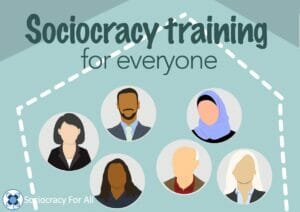Originally published at: https://www.sociocracyforall.org/struggles-in-sociocratic-organizations/
- Struggle 1: No shared aim
- Struggle 2: Not enough feedback
- Struggle 3: Not enough training on governance
- Summary

Governance is never complete and “done”. It needs constant maintenance and fine-tuning. To help you prevent challenges or, get you past them if you’re already experiencing them, I am sharing with you the three most typical struggles in sociocratic organizations.
If you have decided to or already implemented sociocracy or parts of it, congratulations! I’d love to hear how it is going! If you’d like to start and don’t know how, read this.
Struggle 1: No shared aim
The aim of your organization is a description of what you do as a group, the product(s) and/or service(s) you produce the concrete deliverables. It is not the mission or vision, it is more specific and tangible. Your organization’s aim is what you tell people when they ask “so, what do you do”? You don’t tell them “I make the world a better place.” Instead, you might say I work for an organization that provides healthy meals-to-go for college students in Brooklyn. In that case, the aim is “providing healthy meals-to-go for college students in Brooklyn”.
It is essential for the aim to be written down, thoroughly discussed among group members, and its understanding shared by everyone in the group. This is easy to miss. Especially when an organization is just forming and excitement is high. Everyone is enthusiastic and happy to contribute. It’s the honeymoon phase of the organization. We’re together and we all want the same thing… right?
How to notice you have no shared aim
You might get your first hunch that a shared understanding is lacking when someone says something and deep inside you realize that there are different assumptions in the room about what your organization should actually do. Or you notice people resisting and objecting to what’s being said and strong emotions are showing up. For instance, you thought you’d open a storefront, and now some are talking about focusing on the webshop. Or, you thought you had agreements that the restaurant you all want to start would be in Brooklyn, now some people from your team are considering other potential venues and really liking a venue in Manhattan.
A fresh start-up might ignore the lack of clarity for a while. The problem is, those differences typically become part of the DNA of the organization, meaning that they will perpetuate themselves and be present in all of the work of the group or organization. Some people stay in because they want the webshop, some want the storefront. You keep working on growing your organization but the underlying conflict remains and the experience of overall cohesion is missing.

Lack of clarity about the organization’s aim poses a problem for any organization. In a hierarchical organization, this can be compensated for more easily someone high in the hierarchy just decides what is happening. Lack of clarity about the aim is a big problem for sociocratic organizations. Why? Because consent decision-making only works when we have a shared aim.
The organization’s aim is the foundation for the aims of its workgroups (circles). Any circle’s aims are a subset of the organization’s aim. Consent decision-making only works if we can have a way of dealing with objections. An objection to a proposal is defined by “carrying out this proposal would interfere with accomplishing the circle’s aim”. If you don’t know what exactly your aim is — how will you know when to object to a proposal? And more importantly for day-to-day practice, how will you know how to process an objection so that it is in alignment with the aim?
The best way to think about the aim of an organization is to think of it as an invitation. Successful restaurants distinguish themselves from the competition by being very specific about their invitation. Italian or Indian? Fast service or elegant? There also has to be truth in advertising. You would not advertise Thai if that’s not what you are serving. This also applies to aims in any unit of an organization; every circle needs its aim written down in a specific way.
It is the same for an organization. You have to be honest, clear and specific. You and your co-founders set the aim, and new staff and new customers decide whether they want to accept the invitation. If you compromise on aim clarity, it is going to hurt down the road as the organization grows.
What you can do to get clarity on your shared aim
If you notice that you started out with a lack of clarity around the aim, then speak up and get clarity. If your organization’s aim is written down but not specific enough (which can happen easily), and it leads to issues, speak up and get clarity. You will have to treat this as a proposal to the highest circle you have.
It might happen that you realize that it would be best to design an improved circle structure, e.g. to split the group. For instance, if part of the group is pushing for a store in Brooklyn, and part of the group fell in love with a location in Manhattan, maybe it is better to give both groups what they want, instead of staying together and remain paralyzed.
What to say to start the conversation about your aim
Here are a few phrases to start this conversation.
- “I am noticing that we keep running into issues, and I am wondering whether they might have a common core. Maybe we are aligned in our vision but we differ slightly on how we want to achieve our vision. That’s not bad or good, it just is. I think we would benefit from having more clarity. I don’t want to keep dealing with symptoms, I want to talk about what is underneath.“
- “It has been coming to me that we all want the same thing but we want to do it in a different way. I’d like to have a conversation about it to see if maybe we can write up an aim we can all agree to. If that aim is phrased so that it is specific, then we would not have to re-invent the wheel all the time but we’d have some guidelines for our decision-making. I know we’d all prefer to just read each other’s minds but I think in the long run, having more clarity would help us.“
Struggle 2: Not enough feedback
Some people like complaining. So and So always wants her way. So and So holds on to too much power. They’re not accountable. When we in Sociocracy For All hear complaints like that, our standard response is: well, did you tell them that’s that how you perceive them? The answer is often a startled “well… no”.
Complaining is very easy. But all who complain instead of giving feedback have a part in enabling the behavior they complain about. If you don’t speak up — how do you expect things to change? You cannot expect people to read your mind. We cannot change other people’s behavior. Only they can change their own behavior. We can give them feedback. And that’s a very powerful thing to do.
How you notice there’s not enough feedback
You know you are depriving yourself and each other of feedback when people start talking behind each other’s back. Or when, after a meeting, you have post-meeting discussions where some people stay and critique the meeting and what has been said. Any kind of gossip should be a warning sign. You should be very alarmed when people roll their eyes during meetings or express their emotional state in any other non-constructive way.
What you can do to move into constructive feedback
Open up the channels for feedback, so you can step out of complaining mode and into constructive feedback.
In a sociocratic organization, feedback is part of the package. Since it is very easy to slip out of the habit of giving feedback, sociocracy creates “pit stops” where feedback can happen. That way we remember to take a break and evaluate. For instance, every meeting gets evaluated in the meeting evaluation. Every member in roles (like the facilitator) receives feedback in role improvement sessions. Policies always have a term date, and as the term date gets closer, we will evaluate the policy, review it and modify it if necessary. That way, policy will stay current, relevant, dynamic, and fresh on everyone’s mind. Feedback and evaluation are the antidote to becoming stagnant. Feedback is used for improving workflow, process, content, data and interpersonal communication. In short: for everything.

If you are sociocratic on paper but you only go through the motions, you are missing out on opportunities to grow. It is easy to slip into a habit of superficial evaluations. “Good meeting” can mean a thousand things. What made it great? Was is that you got through all the agenda items? Or was it is the sense of connection between people? Was is that the meeting ended on time? Encourage circle members to say more. You can give feedback on process, on content, or on communication. Feedback always gives us information: either about something that can be improved, or on something that is working well for people. If it worked well for people, we have to be sure to keep it up or even do more of it.
Feedback always gives us information: either about something that can be improved, or on something that is working well for people.
What you can say to increase feedback
The best way to introduce more feedback on a deeper and more specific level is to model it by giving feedback or to invite it by asking for feedback. It is very effective to explicitly invite feedback about yourself while making it very clear that your interest in hearing the feedback is genuine.
- “I am interested in seeing how we can make this even more awesome, and it would help me if people would stop and reflect on what we could make better. Sometimes things are really easy to fix, so if you have an idea, and you can tell us exactly what’s going on for you and what you’d like instead, we might be able to tweak things more and more.“
- “I have been a facilitator for 6 months now, and I would really like to know what I am doing that works for you and what doesn’t. It would be most helpful if you could be really specific, with what you like and what you would like me to work on. I really want to know what you think because you know me well and I trust that you want to help me do my job better. For instance, how is my pace, am I too fast, too slow? I sometimes feel like I am moving on to fast, is that true for you? Are my prompt for rounds clear enough? Should I intervene more, or not? I’d love to do one round, just 10 minutes or so, where people tell me what they are thinking.“
Struggle 3: Not enough training on governance
As my colleague, Jerry Koch-Gonzalez says, “Sociocracy does not need strong leaders. It needs strong followers.” Sociocracy does not depend on leaders that much, it depends on good groups. So how can we make sure we have strong followers?
How to notice there’s not enough training on governance
Since everyone is involved in governance, anyone can be an obstacle to flow within your organization. For instance, there will be no flow if people are not clear about the purpose of a round, the definition of an objection or the steps of an election. It just takes one person who keeps cross-talking during rounds and it will be harder for the whole group to even remember where in the round they were before they got interrupted. Some members might be able to learn “on the job”. But if we have a critical mass of people who are not familiar with the practices, then the process falls apart. If there is no flow in your process, then effectiveness and joy suffer. Ideally, you want all of your members to know how things work.
Train as many people as possible. Remember that knowledge is power, and if we want people to be empowered, they have to be trained. If someone does not dare to speak up because they are not sure when and how to do it, then the best governance system will not help you.

In addition to knowing how to do things, members also need to know why we do choose to do processes in a certain way. For instance, I have been around groups wanting a “less formal” structure and they decided to meet without a secretary and delegate. They wanted to just decide at the moment so things would not be “over-engineered”.
Guess what happened? They forgot to take notes and had to scramble to figure out what they had decided in their previous meeting. Had they been more aware of why we have a designated secretary, they would not have skipped having one. Another example: I have seen numerous decision-making processes where the step of clarifying questions was skipped and when it was time to give consent, a number of urgent questions popped up and things got really messy. (“Are we asking questions or are we consenting?”, “I cannot consent when I don’t understand the proposal.”) We have to be intentional about what we do. Some people think that a meeting has to be informal to be fun. I say, we can have fun and still be intentional. We will be rewarded in flow and productivity — even more fun!
Another typical mistake is for groups to keep too much power in the general circle — the coordinating circle consisting of leaders and delegates of their main department circles. In sociocracy, we want to distribute power to the lowest level possible. However, if a group does not have enough awareness and uses sociocracy superficially without understanding the depth of the change, they are often tempted to stick to old patterns. This often comes from a place of fear of lack of control. In the case of the general circle, the desire for control will keep too many decisions on higher levels. Centralized power will inhibit growth and innovation in the organization. Training is essential to make sure everyone has a good understanding of how and why we do things and feels comfortable doing it.
What you can do to introduce more training
In every group, there are people who find the process “overdone” and try to skip it. They need to be reminded — not because we want to play “governance policy” but because we have good reasons to stick to agreed-upon processes that work for the group and serve a purpose. The processes in sociocracy are not arbitrary rules, they are best practices and in the best interest of the group. The more people know, the less resistance there will be.
A small tool that I have found very helpful is a facilitator who frames every element of a meeting. I call it “facilitator with live commentary”. For instance, introduce every round reminding people what is being asked and why. It does not have to be wordy. Here are some examples:
- Ok, now that we have read the proposal, let’s do a round of clarifying questions. I want to make sure everyone understands the proposal so we don’t waste time talking about wrong assumptions about what the proposal says. If you understand the proposal, just say “pass”, or “I understand the proposal”.
- Now we will do one round for quick reactions so people can share what they like or don’t like about the proposal. Let’s keep them really brief. That way, we can be sure we have enough time to incorporate objections which is where our focus should be.
Besides facilitation with live commentary, there is explicit training. There are numerous ways of getting training. You can invite a coach to your meeting in person or by video conference. You can attend webinars or watch videos on youtube. You can form a government improvement circle that provides training for everyone. The best way to go about it is to strive to always educate yourself. You want to get better at your work. Aim to also get better in your governance. We all want a sense of dignity from doing good work well.
Remember to use your struggles as feedback. Instead of getting frustrated, get curious and try to find out what the underlying issue is. Self-governance is help-repairing. That does not mean you have to do things without help from the outside — of course, you can ask for help. “Self-repairing” means that your self-governance is your own. You are responsible to keep it healthy.
Summary
Here the three most common struggles in sociocratic organizations and what you can do about it:
- No shared aim → speak up and get clarity about it, e.g. making a (group) proposal.
- Not enough feedback → open up the channels for constructive feedback and evaluation.
- Not enough training in governance → introduce training in explicit (e.g. get a coach, invite to a webinar event) and implicit (e.g. the facilitator reminding processes step-by-step during a meeting).

